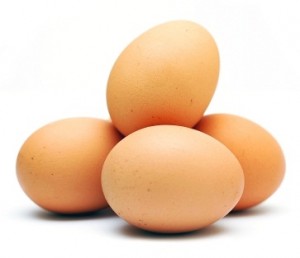For most bodybuilders, pushing through punishing workouts day in and day out is actually the easier part of their regimen. Much harder is sticking with a diet that maintains an anabolic state that is, building muscle for the 22 or 23 hours a day when our bodies are desperately trying to recuperate between workouts. Luckily, nutrition need not be akin to rocket science. This simple checklist runs down eight top foods for mass building.

#1 Beef
When it comes to mass-building foods, nothing trumps red meat. It is packed with protein and loaded with naturally occurring creatine–not to mention blood-building iron. Some cuts are high in fat, so be choosy when it comes to the type you drop on the grill. We recommend eye round, sirloin tip, bottom round, top sirloin and 95% lean ground beef, all of which have only about six grams of fat per six-ounce serving to go with 36 g of protein. Aim for one or two servings per day.
#2 Chicken & Turkey
On average, six ounces of skinless chicken breast contains a whopping 40 g of protein and a paltry 2 g of fat. Turkey breast is even more nutrient dense, with 42 g of protein and only 1 g of fat per six-ounce serving. You can eat as many as four servings of chicken or turkey per day with little fear of adding anything other than quality muscle mass.
#3 Eggs
 Eggs have been labeled the “perfect food.” They contain one of the highest-quality sources of protein available and a range of vitamins and minerals. Egg protein sports an extremely high biological value (the method used to determine how much of the protein is absorbed and retained in the body). To keep fat intake low, a general rule of thumb is to remove four yolks from every six eggs you eat. A six-egg omelet (six whites and two yolks) each morning is a great way to get your protein intake off on the right foot, giving you a sizeable 28 g of protein with 10 g of fat.
Eggs have been labeled the “perfect food.” They contain one of the highest-quality sources of protein available and a range of vitamins and minerals. Egg protein sports an extremely high biological value (the method used to determine how much of the protein is absorbed and retained in the body). To keep fat intake low, a general rule of thumb is to remove four yolks from every six eggs you eat. A six-egg omelet (six whites and two yolks) each morning is a great way to get your protein intake off on the right foot, giving you a sizeable 28 g of protein with 10 g of fat.
#4 Tuna
There are plenty of fish to choose from when seeking a high-quality muscle-building source, tuna being one of the best. As with most fish, tuna is high in protein, delivering 44 g of protein per six-ounce serving.
#5 Milk
Dairy products offer slow-digesting protein that provides a steady supply of aminos over several hours.
In addition to having 8 g of protein, an eight-ounce glass of skim milk also contains a lot of vitamin D and calcium, both invaluable for bone maintenance, muscle strength, muscle growth and fat loss.

#6 Brown Rice
Why brown rice over white? The carb content may be similar, but the body burns brown rice at a slightly slower rate because all but the outermost hull is left on the kernel, meaning there’s an extra dense layer to be digested. Since it burns slower, brown rice will help provide sustained energy through your workouts. Because the outer layers are largely left intact, brown rice is also more nutrient-rich than white. More than 90% of rice’s vitamin [B.sub.6] is lost in the conversion from brown to white rice. Eat one to two cups of brown rice per day, limiting intake after 5 PM.
#7 Yams
 Yams are another excellent slow-burning carb source providing more than just macronutrients. A cup of diced yams contains more than 25% of the U.S. Dietary Reference Intakes of vitamin C and potassium. Yams are high in fiber, one of the reasons it takes so long for the body to process this orange root. Try alternating yams with brown rice as a carbohydrate source in one or two eight-ounce servings per day.
Yams are another excellent slow-burning carb source providing more than just macronutrients. A cup of diced yams contains more than 25% of the U.S. Dietary Reference Intakes of vitamin C and potassium. Yams are high in fiber, one of the reasons it takes so long for the body to process this orange root. Try alternating yams with brown rice as a carbohydrate source in one or two eight-ounce servings per day.
#8 Nuts & Seeds
The next time you’re feeling peckish during the middle of the day, grab a handful of nuts or seeds instead of something sweet and fast burning. Although high in fats (particularly healthy unsaturated), most nuts are nutrient-dense and contain beneficial antioxidants and protein. The U.S. Food and Drug Administration has stated that, “Eating 1 1/2 ounces per day of most nuts as part of a diet low in saturated fat and cholesterol may reduce the risk of heart disease.”
On the FDA’s list of most beneficial nuts are almonds, hazelnuts, pecans, some pine nuts, pistachio nuts and walnuts. For measurement purposes, 1 1/2 ounces equates to between 30 and 36 almonds.
Written By: Shawn Perine FLEX
www.flexonline.com
COPYRIGHT 2007 Weider Publications
COPYRIGHT 2008 Gale, Cengage Learning










